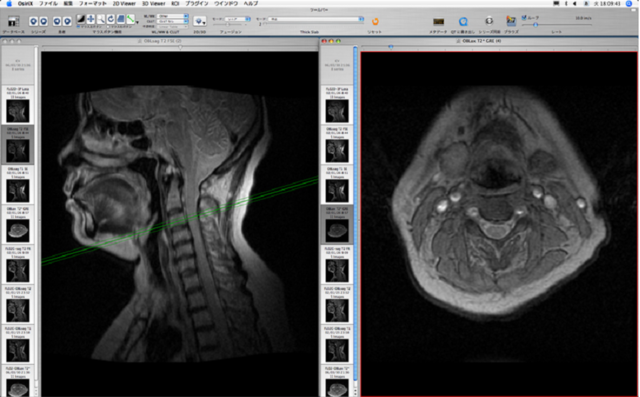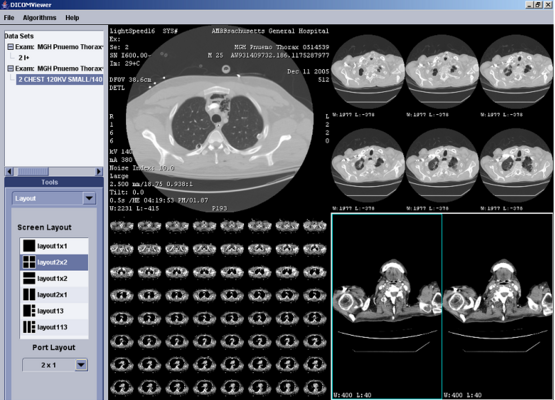Difference between revisions of "Events:August2008XNATDesktop"
(→notes:) |
|||
| Line 45: | Line 45: | ||
Also see XNAT Desktop [http://www.slicer.org/slicerWiki/index.php/Slicer3:XND tutorial] for Slicer. | Also see XNAT Desktop [http://www.slicer.org/slicerWiki/index.php/Slicer3:XND tutorial] for Slicer. | ||
| − | * StoreXAR doesn't currently have | + | * StoreXAR doesn't currently have the functionality in the the use case described (getting xnat's uri back once a file is uploaded). |
* Tim's suggested workaround for now: separately request a catalog of all files for a given session id. This is similar to what would be returned by StoreXAR as described in the use case. | * Tim's suggested workaround for now: separately request a catalog of all files for a given session id. This is similar to what would be returned by StoreXAR as described in the use case. | ||
* [http://central.xnat.org/archive/catalogs/xnat:imageSessionData/BC_CT_TOR_1_1 log into central.xnat.org and click this link to see catalog] | * [http://central.xnat.org/archive/catalogs/xnat:imageSessionData/BC_CT_TOR_1_1 log into central.xnat.org and click this link to see catalog] | ||
Revision as of 19:38, 20 August 2008
Home < Events:August2008XNATDesktopPlans for the Integration of XNAT desktop and Slicer
Contents
Visit of XNAT team to Boston
- Tentative Date: August 21-22nd
- Location: 1249 Boylston Street, 2nd floor demo room Directions to 1249 Boylston
- Agenda/Goals
- Attempt to get base use case worked through
- upload files to XND
- query for them
- download them as a group
- modify them in slicer
- re-upload new files with tags
- Thursday 10am Eastern discussion with Dan Blezek about intersection with XCEDE web services implementation.
- Thursday 11pm Eastern XND Demo and discussion of local use case (C-F, Johanna, Monika)
- Attempt to get base use case worked through
- XND User Interface Review with Wendy
- People: Misha, Kevin, Wendy, Nicole, Steve, Ron (Thursday)
Other Topics
Misha to meet with Bernhard about deidentification algorithms for full body CT scans.
Use-case scenarios
External examples
Use Scenario 1
- I am using Slicer on my laptop and would like to use XNAT desktop to keep data organized on my hard disk
Capabilities needed
- how to set up when I download slicer?
- I am upgrading Slicer do I need to upgrade xnat as well?
- I worked today on a case. I would like to add my derived data and new mrml file to the existing stuff.
- I would like to upload stuff that is currently in Slicer
- I would like to download a mrml file and all associated data files.
notes:
See use case for discussion (XNAT tools extension): Slicer use case (similar to above).
Also see XNAT Desktop tutorial for Slicer.
- StoreXAR doesn't currently have the functionality in the the use case described (getting xnat's uri back once a file is uploaded).
- Tim's suggested workaround for now: separately request a catalog of all files for a given session id. This is similar to what would be returned by StoreXAR as described in the use case.
- log into central.xnat.org and click this link to see catalog
- There's not currently a commandline executable -- we will have to write this.
- The HTTP Session ID needs to be attached to the HTTP Request.
technical questions:
- What are preferred ways to access web services – such as e.g. shell scripts calling cURL, some preferred C++ web client, Python or Java programs?
- What are requirements for XNAT File Repository web services security model?
- What would be a typical workload for various types of queries to XND (XNAT Desktop) repository - including seach, file put and file get?
- Currently, XNAT Desktop supports single file manipulation. Should it, (and if it should, then to what extent?) support treating a set of files as a single 'bundle' (for instance, "MRML file and all associated files")? What criteria should it support to automatically identify a set of files as belonging to one bundle?
- Will XNAT Desktop have to use Slicer ontology for basic tags (Project, Subject, Experiment, Scan) or will Slicer adopt, to some extent, XNAT ontology? (XNAT ontology is required to be used by Desktop when interacting with hosted XNAT Enterprise server).
Advantage Windows experience
Reference
http://slicer.spl.harvard.edu/slicerWiki/index.php/Slicer3:XCEDE_use_cases#XCEDE_REST_Interface
Comments from Misha
from Aug 18 2008
What do we have to show, from the time of last demo:
- XNAT File repository server supporting newly developed file repository
REST-style Web Services, and (finally) integrated with client-server visual interface (XNAT Desktop a.k.a. XND).
- Kevin will demonstrate types of queries currently supported by Web
Services, File Repository database structure and provide detail on requirements for development of Web Services clients;
- Within this scope, I can also demonstrate ontology generation
approaches used by XND (which were mentioned before, DICOM rule and regular expression rule) - most importantly, these rules are used to generate XNAT ontology from arbitrary hierarchy of files and folders.
- Go over the upload to XNAT Central, using last release of XND visual
interface with improved upload capability.
Points of discussion
- We’d like to see a detailed use case for the Slicer integration, so
that we could go over missing pieces in more detail. Some of the missing/unclear pieces are listed below, but it will be crucial to have a list of possible pitfalls, as complete as possible.
- Typical use of XNAT File Repository: will it be used as a local
repository for Slicer projects, a hosted research data archive, a remote/back-up/secondary repository for cross-institutional data sharing, anything else?
- Prefedded way of accessing web services – such as e.g. shell scripts
calling cURL, some preferred C++ web client, Python or Java programs – to test against most probable client platforms.
- Scaling: anticipated density of Web Services requests of each type
(i.e. various types of search (file search, metadata search), file put / file get), from a typical Slicer client;
- Resource access control (resource-based) / session based user
authentication model, other sequrity issues? Preferred security model (or at least requirements to the security model)?
- Use scenarios for XND client: standalone tool for tagging data and
transferring between centralized repository and/or local users; PACS worklist-like interface for navigating DICOM data/launching viewing tools for clinical radiologists; anything else?
- Most desired features of the XND client: metadata
organization/control, search/filtering features, interface organization from user perspective
- Support for Slicer ontologies, ontology conversion, ontology migration
issues which will arise as soon as existing data archive will need to be converted to XNAT file repository;
- other suggestions/critiques/clarifications?

